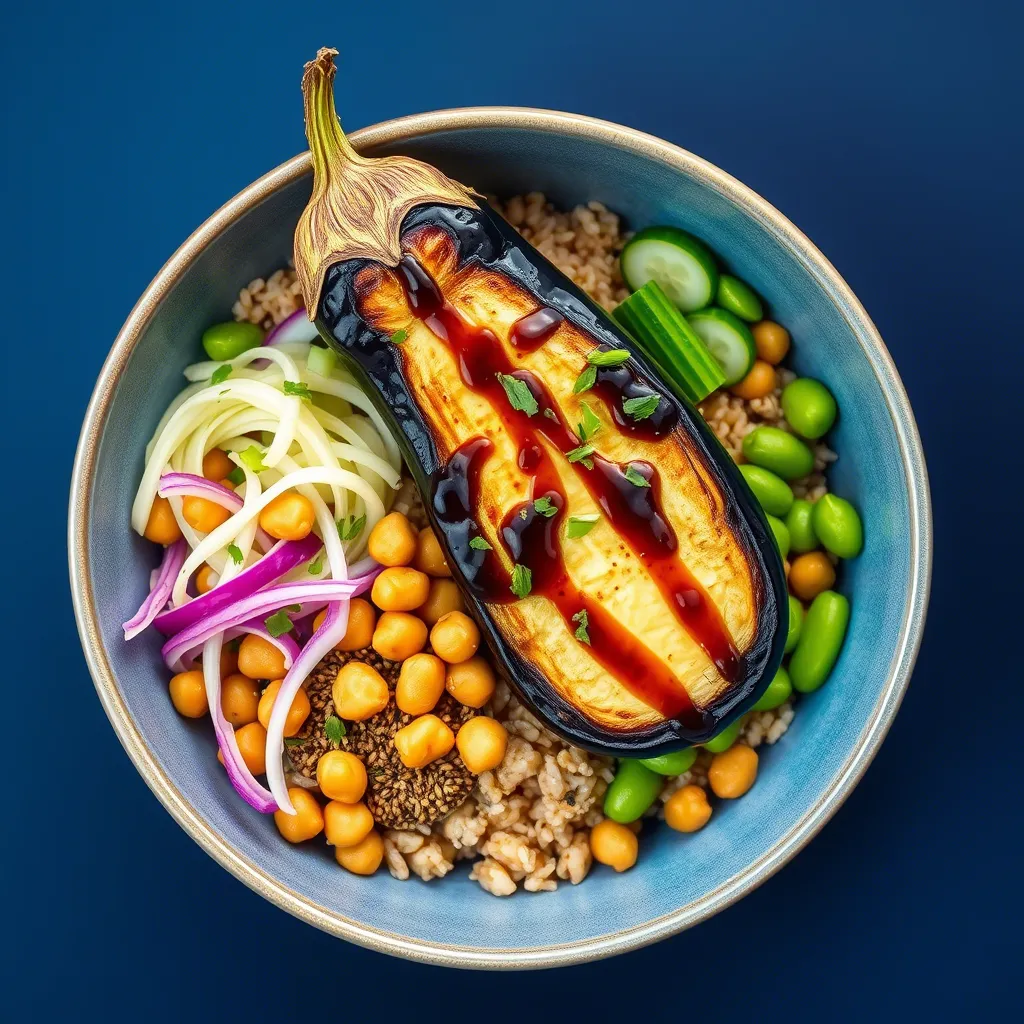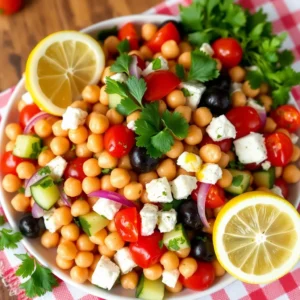Why You’ll Love These Miso Roasted Eggplant and Chickpea Bowls
There’s something magical about a perfectly roasted eggplant – that melt-in-your-mouth texture that soaks up flavor like a culinary sponge. And when you pair it with the umami richness of miso? That’s when kitchen magic truly happens. These miso eggplant bowls aren’t just another lunch recipe; they’re a revelation in a bowl that will transform your midday meal from an afterthought to the highlight of your day.
As a busy parent (or professional, or both!), I know that lunchtime often becomes that forgotten meal – the one where we’re throwing together whatever’s easiest or, worse, skipping altogether. These bowls are my answer to the eternal question: “How do I make a lunch that’s actually worth stopping for?” They’re substantial enough to power you through afternoon meetings but won’t leave you feeling like you need a nap under your desk afterward.
What makes these miso eggplant bowls special is how they strike that perfect balance – they’re hearty but not heavy, complex in flavor but simple to prepare. The eggplant develops this incredible caramelized exterior while staying tender inside, and the chickpeas transform into crunchy little flavor bombs. It’s plant-based eating that never feels like a compromise.
For the busy parents out there (I see you!), these bowls can be partially prepped on Sunday, then assembled in minutes during the week. And unlike some meal prep options that feel sad and soggy by Wednesday, these components actually get better as they sit and the flavors meld together. How many lunches can claim that superpower?
If you’re trying to incorporate more plant-based lunches into your routine but struggling with options that keep you satisfied, this recipe is your new best friend. The protein-packed chickpeas and fiber-rich eggplant create a meal that sticks with you, while the miso dressing adds that umami element that makes your taste buds think they’re getting something much more indulgent.
What I really love about these bowls is their versatility. Having a crazy week? The components can be prepped up to three days ahead. Feeding picky eaters? Let everyone build their own bowl with their preferred toppings. Need to use up whatever’s in the fridge? Almost any veggie can be roasted alongside the eggplant or tossed in raw at the end. It’s the Swiss Army knife of lunch recipes.
And let’s be honest – we eat with our eyes first, and these bowls are absolutely gorgeous with minimal effort. The deep purple of the eggplant against the golden chickpeas, maybe a sprinkle of vibrant herbs or a drizzle of sauce… it’s Instagram-worthy without trying too hard. In fact, if you love beautiful food presentations, you might also enjoy my Cucumber Tomato Salad which brings the same level of vibrant, colorful appeal to your table.
The Story Behind These Miso Roasted Eggplant and Chickpea Bowls
I stumbled upon the magic of miso and eggplant completely by accident. It was one of those chaotic weeknights – you know the kind – where the fridge was nearly empty, and I was standing there with a lone eggplant and a prayer. My youngest had just declared she was “going vegetarian this week” (spoiler alert: it lasted exactly three days), and my oldest was in that growth spurt phase where he’d become a human vacuum cleaner.
There I was, wondering how to transform this single eggplant into something that would satisfy these wildly different appetites, when I remembered the tub of miso paste lurking in the back of my fridge. It had been sitting there since that ambitious phase when I’d decided to make homemade miso soup from scratch (we all have these culinary ambitions, don’t we?).
With nothing to lose, I slathered some miso on eggplant slices, threw in some chickpeas I’d found in the pantry because, well, protein, and roasted the whole thing while I frantically searched for something else to serve alongside it. But when I pulled that pan out of the oven… the aroma that filled my kitchen was nothing short of intoxicating. Sweet, savory, and deeply complex.
To my absolute shock, both kids not only tried it but fought over seconds. My husband, who typically views eggplant with deep suspicion, asked if we could add this to our regular rotation. That night, scribbling down what I’d done before I forgot, these miso eggplant bowls were officially born.
Since then, this dish has become something of a legend in our household. It’s the meal I make when friends come over and I want to seem effortlessly sophisticated (don’t worry, I’ll never tell them how simple it actually is). It’s my go-to for meal prep Sundays, and the dish I taught my teenager to make before heading off to college because “trust me, you’ll impress everyone in your dorm.”
There’s something deeply satisfying about creating a meal that nourishes not just bodies but souls. These bowls have become more than just lunch – they’re the meal I make when someone’s had a rough day, or when we need to reset after too many takeout dinners. They’re comfort food disguised as a fancy lunch bowl.
I’ve served these at summer picnics and winter gatherings. I’ve packed them in lunchboxes and plated them for dinner parties. I’ve made them for new mothers, sick neighbors, and friends going through tough times. There’s something about the combination of humble ingredients transformed into something special that just says “I care” without saying a word.
So as you make these miso eggplant bowls in your own kitchen, know that you’re not just following a recipe – you’re continuing a story that’s brought a lot of joy to my table. And isn’t that what cooking is really all about? Creating memories, one delicious bite at a time.
Ingredients
Let’s gather everything we need for these miso eggplant bowls – I’ll walk you through each ingredient and why it matters, plus some easy swaps if you need them!
For the roasted eggplant:
- 2 medium eggplants (about 2 pounds total) – Look for firm, glossy eggplants with no soft spots. The smaller ones tend to have fewer seeds and a sweeter flavor. If eggplant isn’t your thing (though this recipe might change your mind!), zucchini or portobello mushrooms can work as alternatives.
- 3 tablespoons olive oil – This helps the eggplant roast instead of steam. You could substitute avocado oil if you prefer its neutral flavor.
- 1 tablespoon sesame oil – This adds that distinct nutty flavor that elevates the dish. Toasted sesame oil packs more punch, but regular works fine too.
- 3 tablespoons white miso paste – The star ingredient! Miso is fermented soybean paste that brings incredible umami flavor. White miso (shiro miso) is milder and sweeter than other varieties. If you can only find red miso, use a bit less as it’s stronger.
- 2 tablespoons maple syrup – Balances the saltiness of the miso with natural sweetness. Honey works too if you’re not strictly plant-based.
- 1 tablespoon rice vinegar – Adds brightness and acidity. Apple cider vinegar can pinch-hit in a desperate moment.
- 2 cloves garlic, minced – Because almost everything tastes better with garlic! Garlic powder (½ teaspoon) works in a pinch.
- 1-inch piece ginger, grated – Brings a zingy freshness. Ground ginger (½ teaspoon) is an acceptable substitute but lacks the same punch.
- ¼ teaspoon red pepper flakes – For just a hint of heat. Adjust up or down to your preference, or substitute a squirt of sriracha.
For the chickpeas:
- 2 (15-ounce) cans chickpeas, drained and rinsed – The protein powerhouse of our bowl. Black beans or white beans can substitute if needed.
- 2 tablespoons olive oil – Helps achieve that magical crispiness.
- 1 teaspoon ground cumin – Earthy warmth that pairs beautifully with chickpeas.
- 1 teaspoon smoked paprika – For a subtle smoky flavor that makes these taste extra special.
- ½ teaspoon garlic powder – Provides even flavor distribution throughout the chickpeas.
- ½ teaspoon salt – Enhances all the other flavors.
- Freshly ground black pepper – Because pre-ground just isn’t the same!
For the bowl base:
- 2 cups cooked grain of choice (brown rice, quinoa, farro, or barley) – I love using hearty grains that stand up to the other components without getting soggy. Cook with vegetable broth instead of water for extra flavor!
- 4 cups baby spinach or mixed greens – Adds freshness, color, and nutrients.
For the miso dressing:
- 2 tablespoons white miso paste – Creates consistency between the roasted elements and the fresh components.
- 2 tablespoons rice vinegar – For brightness.
- 1 tablespoon sesame oil – Carries the flavors and adds richness.
- 1 tablespoon maple syrup – Balances the saltiness.
- 1 tablespoon water – To achieve the perfect drizzling consistency.
- 1 small garlic clove, finely grated – Raw garlic adds a pleasant bite.
For toppings (choose your favorites):
- 1 avocado, sliced – Adds creaminess and healthy fats.
- ¼ cup chopped green onions – For fresh, mild onion flavor.
- 2 tablespoons toasted sesame seeds – Adds crunch and visual appeal.
- Fresh cilantro leaves – Bright, citrusy notes.
- Pickled ginger – Adds zing and beautiful color.
- Cucumber slices – For cool crunch.
- Radish slices – For peppery bite and color.
- Lime wedges – For a fresh squeeze before eating.
What I love about this ingredient list is how many of these items are pantry and refrigerator staples. Once you invest in a good tub of miso paste (which lasts for months in the refrigerator), you can make these bowls anytime you have eggplant on hand. Even better, many of these ingredients appear in other recipes across cuisines, making them versatile additions to your pantry. If you enjoy these flavor profiles, you might also like my Shrimp Fried Rice Recipe which uses similar Asian-inspired seasonings.
Execution
Let’s break down how to make these miso eggplant bowls, step by step, so even on your busiest days, you can make this happen without breaking a sweat!
Preheat and Prep (10 minutes):
- Position your oven rack in the middle and preheat to 425°F (220°C). This high heat is crucial for developing that caramelized exterior on both the eggplant and chickpeas.
- Line two baking sheets with parchment paper or silicone mats. Trust me on this one – it makes cleanup infinitely easier, especially with the sticky miso mixture.
- Cut the eggplants into 1-inch cubes. No need to peel them – the skin holds nutrients and helps the cubes keep their shape during roasting. Pro tip: If you have time, place the cut eggplant in a colander, sprinkle with a little salt, and let sit for 15 minutes to draw out any bitterness. Then pat dry with a paper towel before proceeding. This step is optional but worth it for larger, more mature eggplants.
Make the Miso Marinade (5 minutes):
- In a large bowl, whisk together the olive oil, sesame oil, miso paste, maple syrup, rice vinegar, minced garlic, grated ginger, and red pepper flakes until smooth. The mixture should look like a thick, caramel-colored sauce.
- Add the eggplant cubes to the bowl and toss gently with your hands or a spatula until every piece is coated. Be thorough but gentle – eggplant can bruise easily.
Prepare the Chickpeas (5 minutes):
- Drain and rinse the chickpeas, then pat them dry with a clean kitchen towel or paper towels. The drier they are, the crispier they’ll get – this is a game-changer step that many recipes skip!
- In a medium bowl, toss the chickpeas with olive oil, cumin, smoked paprika, garlic powder, salt, and pepper until evenly coated.
Roast the Vegetables (25-30 minutes):
- Spread the miso-coated eggplant in a single layer on one prepared baking sheet. Give the pieces some breathing room – overcrowding leads to steaming instead of roasting.
- Spread the seasoned chickpeas in a single layer on the second baking sheet.
- Place both sheets in the preheated oven. The chickpeas will need about 20-25 minutes until golden and crispy, while the eggplant needs 25-30 minutes until caramelized and tender.
- Halfway through cooking (around the 12-15 minute mark), use a spatula to flip the eggplant pieces and give the chickpeas a good shake or stir. This ensures even browning on all sides.
Make the Miso Dressing (5 minutes):
- While everything roasts, whisk together all dressing ingredients in a small bowl until smooth and well combined. If the dressing seems too thick, add an extra teaspoon of water until it reaches a pourable consistency.
- Store in the refrigerator until ready to use. The flavors actually improve if it sits for a few minutes!
Prepare Your Bowl Base:
- If your grains aren’t already cooked, now’s the time to prepare them according to package instructions. For maximum flavor, cook them in vegetable broth rather than water, and add a bay leaf if you have one on hand.
- I find that 1/2 cup of cooked grains per bowl creates the perfect balance, but adjust according to your hunger level and preferences.
Assemble the Bowls:
- Start with a bed of greens in each bowl, then add your warm grains in one section.
- Arrange the roasted eggplant and crispy chickpeas in their own sections.
- Add your chosen toppings – avocado slices, cucumber, radishes, or whatever you’re using.
- Drizzle everything with the miso dressing.
- Finish with a sprinkle of green onions, sesame seeds, and cilantro.
The assembly process is where you can get creative and make these bowls your own! I love arranging the components in distinct sections for a beautiful presentation, but you can also toss everything together if you prefer. According to a fascinating article on Food Psychology by Harvard Health, how we visually present our food actually impacts how we perceive its taste, so taking that extra minute for presentation can make your lunch experience even more satisfying.
What I love most about these miso eggplant bowls is their flexibility. If your chickpeas get done before the eggplant, no problem – they taste great at room temperature too. If you’re meal prepping, store the components separately and assemble just before eating. The dressing will keep for up to a week in the refrigerator, so you might want to make a double batch!
Additional Tips
These miso eggplant bowls are already fantastic as written, but let me share some insider tips and variations that will help you make this recipe your own and navigate any challenges that might come up!
Making Perfect Roasted Eggplant: The secret to perfectly roasted eggplant is giving it space on the baking sheet. Crowded eggplant steams rather than roasts, robbing you of that caramelized exterior that makes this dish special. If you’re doubling the recipe, use additional baking sheets rather than cramming everything onto one.
If you’ve struggled with bitter eggplant in the past, take the extra few minutes to salt it before cooking. After cutting into cubes, place the eggplant in a colander, sprinkle generously with salt, and let it sit for 15-30 minutes. The salt draws out bitter compounds along with excess moisture. Just be sure to rinse the eggplant and pat it dry before proceeding with the recipe.
For extra flavor dimension, try scoring the eggplant cubes lightly with a knife before marinating. These small cuts create more surface area for the miso mixture to penetrate, resulting in even more flavorful bites.
Chickpea Perfection: The key to truly crispy chickpeas is removing as much moisture as possible before roasting. After draining and rinsing, spread them on a clean kitchen towel and gently roll them around to dry. For extra credit, remove any loose skins that come off during this process – they tend to burn in the oven.
If your chickpeas aren’t crisping up as much as you’d like, there’s a simple fix. Once they’ve finished their initial roasting time, turn off the oven, crack the door open, and leave them in there for an additional 10-15 minutes as the oven cools. This gentle finish creates that perfect crunch without risking burnt flavor.
Don’t feel limited to the spice blend in the recipe! These chickpeas are a canvas for whatever flavors you’re craving. Try curry powder for an Indian twist, za’atar for Middle Eastern vibes, or chili powder and cumin for a Southwestern flair.
Storage and Meal Prep: These bowls are meal-prep champions, but a few strategic choices will keep everything fresh and delicious for days:
- Store the roasted eggplant and chickpeas separately from the greens and other fresh components.
- Keep the dressing in its own container until ready to eat.
- If using avocado, either add it fresh at serving time or sprinkle the slices with a bit of lemon juice to prevent browning.
- The roasted components will stay good in the refrigerator for up to 4 days, and they reheat beautifully in a microwave (1 minute) or air fryer (2-3 minutes at 350°F).
For the ultimate grab-and-go lunch, assemble your bowls in mason jars! Layer dressing on the bottom, followed by heartier components like chickpeas and eggplant, then grains, with greens at the very top. When you’re ready to eat, just shake it all into a bowl.
Seasonal Adaptations: This recipe shines year-round with a few seasonal tweaks:
- Summer: Add fresh corn kernels, cherry tomatoes, and basil.
- Fall: Include roasted sweet potato cubes or butternut squash.
- Winter: Try adding roasted Brussels sprouts or massaged kale.
- Spring: Incorporate snap peas, asparagus tips, or fresh peas.
Serving Suggestions: These miso eggplant bowls stand beautifully on their own, but if you’re looking to round out the meal:
- A simple miso soup makes a perfect starter.
- For a heartier meal, add a soft-boiled egg or edamame for extra protein.
- A side of quick-pickled vegetables adds brightness and crunch.
- For dessert, fresh fruit or a small piece of dark chocolate complements the umami flavors.
If you’re entertaining, set up a build-your-own bowl bar! Arrange all components in separate dishes and let guests customize their creations. This approach is particularly great for families with varying preferences or dietary needs.
Trouble-shooting Common Issues: If your eggplant is coming out mushy instead of caramelized, your oven might be running cool. Try increasing the temperature by 25 degrees or moving the rack closer to the top of the oven. Also, make sure you’re using enough oil – eggplant is like a sponge and needs adequate fat to roast properly.
Having trouble getting the miso to incorporate smoothly? Try mixing it first with just the liquid ingredients (oils and vinegar) until smooth, then add the other marinade components. Alternatively, you can warm the miso slightly in the microwave (5-10 seconds) to soften it before mixing.
If you find the overall dish too salty, balance it with a squeeze of fresh lime juice or a drizzle of honey. Too bland? A sprinkle of flaky sea salt or an extra drizzle of the miso dressing will perk things right up.
For more techniques on perfectly roasting vegetables, check out Serious Eats’ guide to roasting vegetables, which offers fantastic science-based tips for achieving that perfect caramelization we’re all after.
FAQs
Can I make these miso eggplant bowls ahead of time? Absolutely! These bowls are perfect for meal prep. Roast the eggplant and chickpeas up to 4 days in advance and store them separately in airtight containers in the refrigerator. The miso dressing will keep for up to a week. For optimal freshness, prep your greens and toppings no more than a day or two ahead. When ready to eat, you can enjoy the components cold or warmed slightly, then drizzle with dressing just before serving.
I’m not a fan of eggplant. Can I substitute another vegetable? Yes! While eggplant works beautifully with miso because of its absorbent nature, you can achieve delicious results with other vegetables. Portobello mushrooms offer a similar meaty texture, or try cauliflower florets, zucchini chunks, or sweet potato cubes. The cooking time might vary slightly depending on your choice, so keep an eye on them as they roast. The miso marinade is versatile enough to complement a wide range of vegetables. For another fantastic plant-based option, check out my Pasta Primavera Recipe, which showcases seasonal vegetables in a completely different way.
Is miso paste gluten-free? This depends on the brand. Traditional miso is made from fermented soybeans, rice or barley, and salt. Miso made with barley contains gluten, while miso made with just rice and soybeans is typically gluten-free. Always check the label if gluten is a concern for you. Most grocery stores carry at least one gluten-free miso option, usually labeled as “white miso” or “shiro miso.”
How can I make these bowls more protein-rich for my active family? While the chickpeas already provide a good amount of plant protein, there are several ways to boost the protein content further. Add a soft-boiled egg, grilled tofu cubes, or edamame to keep it plant-based. For non-vegetarians, grilled chicken, salmon, or shrimp would complement the flavors beautifully. You could also sprinkle hemp seeds or chopped nuts on top for an extra protein boost.
What if I can’t find white miso paste? If white miso (shiro miso) isn’t available, you can substitute red miso (aka miso) or mixed miso (awase miso), but reduce the amount by about 1/3 since these varieties are stronger and saltier. In a pinch, you could substitute 1 tablespoon tahini mixed with 1 teaspoon soy sauce and 1/2 teaspoon honey for every 2 tablespoons of miso paste called for in the recipe. The flavor won’t be identical, but it will provide similar umami notes and creamy texture.
Can I make this recipe oil-free? Yes, though with some modifications. For the eggplant, replace the oils with vegetable broth or a mixture of vegetable broth and a small amount of tahini to help the miso adhere. The chickpeas can be roasted with just the spices (no oil) if you’re using a good non-stick baking sheet or silicone mat, though they won’t get quite as crispy. For the dressing, substitute the sesame oil with either water or a bit of tahini thinned with water for a similar nutty flavor.
How can I adjust this recipe for picky eaters? The build-your-own bowl approach works wonders with picky eaters! Serve each component separately and let everyone assemble their own creation. For children or those new to miso, you might want to use a bit less miso in the marinade and add a touch more maple syrup to highlight the sweeter notes. Starting with smaller eggplant cubes can also help make the texture more approachable. And remember, sometimes new foods need to be offered multiple times before they’re accepted, so don’t get discouraged if it’s not an immediate hit!
My family has been enjoying these miso eggplant bowls regularly since I first created the recipe, and they’ve evolved as we’ve discovered new variations and tweaks. The beautiful thing about cooking is how a recipe can grow with you, adapting to your family’s changing tastes and needs. Whether you follow this recipe exactly or use it as a springboard for your own creative bowl, I hope it brings the same joy to your table that it has to mine.
Remember that cooking should be an adventure, not a source of stress. If your eggplant isn’t perfectly caramelized or your chickpeas aren’t quite as crispy as you’d hoped, that’s perfectly okay! The goal is nourishing food made with love, and these miso eggplant bowls deliver that in spades, even when they’re not Instagram-perfect. So have fun with this recipe, make it your own, and enjoy the process of creating something truly delicious for yourself and those you love.



